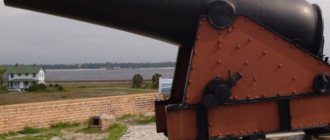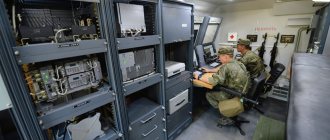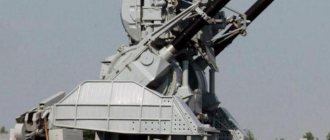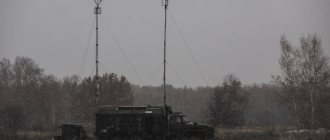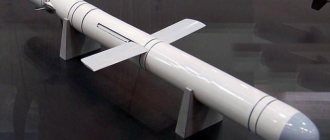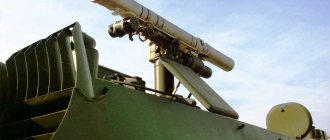The A-222 "Bereg" complex is a self-propelled coastal defense artillery system designed to destroy small and medium-sized ships. The installation is capable of hitting targets moving at speeds of up to 100 knots (about 185 km/h) and firing at ground targets.
This complex was created to counter small and medium-sized enemy ships and protect the coastline. The self-propelled artillery unit is capable of hitting targets moving at speeds of up to 100 knots (about 185 km/h) and firing at ground targets. The A-222 “Bereg” is a mobile combat unit that can take action both in a position prepared for combat and in an unprepared place. Such military equipment, together with cruise missile systems, conduct coastal defense. Excluding one of them is unacceptable. Each has its own “dead” firing zones that can be hit by their defensive partner.
A little history
Previously, the Soviet army in the seventies was armed with the AK SM-4 complex with 130 mm caliber weapons. However, with the development of military-technical progress and the creation of high-speed, powerful warships, he was unable to confront the enemy. New self-propelled units were required for reliable protection of the coastline. This task was assigned to the Titan Central Design Bureau from Volgograd under the leadership of V. A. Shurygin. Development began in 1976, and four years later the documentation for the production of the new complex was ready. The production of the A-222 “Bereg” was entrusted to the long-time partner of the Central Design Bureau, a fellow countryman of the Barrikady Production Association.
There was some hiccups with the start of production. The enterprise's workload with orders and the unstable political situation caused the delay. The first copy was released in 1988. It took another four years to test it, and only in 1992 did the state commission accept it. The test was successful and a year later “Bereg” went to the international exhibition of military equipment in Abu Dhabi, where it also received positive ratings.
Read Electric Train EP1M
Components of A-222 "Bereg".
The mobile artillery complex (MAK) A-222 "Bereg" includes:
- central post (CP), designed to control firing;
- self-propelled artillery units, in the amount of 4 to 6 units;
- vehicles providing combat duty, MOBD (1-2 pcs.).
The fire control system is the Berega CPU.
This part of the complex houses the BR-136 firepower control system. The interior is divided into five parts.
- The command compartment, also known as the operator's compartment. The MAC and CPU commanders are located here. It also contains workplaces for the foreman, the post electrician and the operator - radiometrician. It is here that surveillance, navigation, tracking and fire control systems are installed, as well as communication devices between the CPU and the rest of the complex’s machines.
- Radio operator's room. Information processing center. It employs a telegraph operator and a driver – an electrician. The latter is in charge of the A-222 power supply system.
- Compartment with high-frequency equipment.
- Antenna compartment with transmitting and receiving devices.
- Compartment with diesel emergency power supply.
- The fire control system is capable of finding and tracking up to 4 targets, as well as firing at two points simultaneously. The self-propelled gun can hit the enemy with single shots or in series (4-12 times per minute). For optimal operating conditions of the CPU antenna equipment, the transport is fixed in a horizontal position using jacks. Air conditioners installed inside the post ensure normal operation of devices and people.
Self-propelled gun A-222 "Bereg"
The highlight of the self-propelled gun is the 130-caliber gun. Its aiming occurs in two ways: using the aiming device of the self-propelled gun or according to information from the central post. The first option for peripheral guidance operates in an emergency situation or when the central post fails as a result of damage during combat operations. The crew of the self-propelled gun consists of six people: a commander, a gunner and 4 loaders.
Read Heavy flamethrower system TOS-1A “Solntsepek”
When firing, the self-propelled gun is fixed with 4 jacks, providing the necessary stability for firing.
MOBD MAK support vehicle
The combat duty support vehicle is a kind of universal utility unit on wheels. Inside are:
- Diesel – power plants (2 pcs.), providing power to the CPU.
- Fuel tanks with a week's supply.
- Rest rooms for two and four people.
- Dining room for 4 people, kitchen with food supplies for a week.
- A signaling device that notifies of radiation or chemical hazards.
- The fact that this is still a military vehicle is evidenced by the fact that a 7.62 mm machine gun is mounted on the roof.
Armed Forces. Forum about weapons and the army
The Bereg artillery complex is designed to destroy small and medium surface ships, including high-speed ones, at speeds of up to 200 knots, on the immediate approaches to the coast - in tidal zones, island and skerry areas, as well as to destroy ground targets.
The complex can be deployed at a firing position prepared or unprepared in topological and geodetic terms. It can perform all combat missions assigned to it at any time of the day and in any weather conditions, in conditions of active and passive interference, at ambient temperatures from -50° to +50°.
Contrary to popular belief, coastal gun mounts cannot be replaced by coastal guided missile systems. In BO, as in ground forces, guided missiles and artillery systems do not replace, but only complement each other. All BO cruise missile systems have “dead” (not affected) zones from several kilometers to several tens of kilometers. Missiles are dependent on active enemy interference and can be shot down by ship air defense systems. Cruise missiles are ineffective in skerry areas and, finally, they are much more expensive than cannon artillery shells, especially when firing at small-tonnage and landing craft. For example, during the fighting in Abkhazia, both Georgians and Abkhazians armed small pleasure boats and other watercraft, the cost of which is much less than Termit or P-35 missiles. It should be noted that traditional self-propelled artillery units in service with the ground forces cannot provide effective coastal defense. The control systems included in their composition are not designed to solve specific problems when firing at moving sea targets. Therefore, in order to quickly destroy small-sized floating targets, which are usually used during amphibious landings (combat vehicles, tanks, boats), artillery systems must be equipped with special control systems. In the mid-70s, 130-mm SM-4 artillery mounts were used along with anti-ship missile systems to protect the coast in artillery units of the coastal defense of the USSR Navy. Low mobility and outdated control systems of the SM-4 no longer met modern requirements for the defense of maritime borders. To quickly destroy moving water targets and conduct effective combat operations on the coast, it was necessary to create a new coastal artillery complex. The development of the 130-mm self-propelled complex A-222 "Bereg" began in December 1976 at the Volgograd Central Design Bureau "Titan". In 1980, technical documentation for the new 130-mm coastal self-propelled AK A-222 “Bereg” was transferred to the Barricades Production Association. The first prototype was ready only in 1988, after which its testing began at a test site near Feodosia. The complex was developed until 1992. During state tests, the Bereg, having satisfied all the requirements, showed itself at its best - in front of the customer’s eyes, a large target was effectively destroyed with a direct hit. The complex was first shown to the general public in 1993 at an arms exhibition in Abu Dhabi. In 1996, the coastal AK "Bereg", having passed all the required tests, was adopted by the Navy. In July 2003, “Bereg” was demonstrated in combat position to Russian Defense Minister Sergei Ivanov at the Prudboy training ground in the Volgograd region. In August 2003, the first serial complex became part of the 40th BRAP, assigned to the Novorossiysk naval base. Main characteristics of the complex: Effective firing range - up to 20 km Time to switch to combat position - 5-30 minutes Maximum distance between the CPU and gun mounts: - in range - 1000 m - in height - 300 m Time to hit a moving sea target with a probability of 0. 8 - 1-2 minutes Maximum highway speed - 60 km/h Cruising range - 650 km
The ballistics and ammunition for the gun were taken from the AK-130 shipborne installation (ZIF-94), and a number of elements of the swinging part were taken from the 152-mm Msta self-propelled howitzer (2S-19). Unlike the AK-130 barrel, the Bereg barrel has a powerful muzzle brake and an ejector in the central part of the barrel, while the Berega's rate of fire has decreased by more than 4 times compared to the number of shots per barrel of the AK-130. The vehicles of the Bereg complex are mounted on a MAZ-543M all-terrain chassis with an 8x8 wheel arrangement. The weight of the chassis itself is 21 tons; the D-12A-525A diesel engine with a power of 525 hp is installed on the chassis. The use of a wheeled chassis made it possible to increase the fuel range by 1.7 times and the guaranteed mileage of vehicles of the Bereg complex by 3 times compared to modern self-propelled guns on a tracked chassis. The complex includes a central post (CP) with a fire control system, six self-propelled guns with 130 mm guns and 1-2 combat duty support vehicles (MCV).
SELF-PROPELLED ARTILLERY UNIT
The 130-mm gun of the A-222 self-propelled artillery mount is installed in a turret rotating on a slewing device in the form of a specialized roller bearing, which allows firing at amphibious assault in a wide sector - plus/minus 120 degrees. In the vertical plane, the gun is aimed in the range from minus 5 to plus 50 degrees. Targeting can be carried out automatically using digital codes coming from the central post, or in semi-automatic mode from the sighting device of an artillery mount. In the latter case, it is assumed that the A-222 participates in combat operations autonomously and has no connection with the central post and combat support vehicle. This possibility of autonomous functioning of each of the six self-propelled guns significantly increases the survivability of the Bereg artillery complex as a whole. Four types of projectiles can be used for firing: high-explosive fragmentation with a bottom fuse; - anti-aircraft with a head fuse; — practical (for training shooting); - training for training calculations and checking the material part. The turret is equipped with workplaces for the commander, gunner and four loaders. At the commander’s workplace there is a control unit for the operation of all systems (fire control, guidance, ammunition supply, cartridge case removal, life support, fire extinguishing), an optical-electronic commander’s observation device with a night channel, a quantum range finder, a ballistic computer and a tablet for autonomous operation, a radio station, equipment control of internal and external wired intercom, lighting, heating and ventilation equipment. The gunner at his workplace has an optical sight, a light signaling unit, as well as lighting and intercom equipment. If any obstacles may fall into the shooting zone, the gunner can take this circumstance into account by entering information into a special block for entering the coordinates of prohibited shooting zones, located at his workplace. The workstations of the two front loaders are organized at the shot feed trays symmetrically to the axis of the barrel bore. The rear loaders' positions are located at the ammunition racks and their loading device. There are also two stowages for storing and transporting at least 40 shots. Next to the movable turret, an aggregate compartment is installed on a vehicle chassis, which contains a power unit to drive the electromechanical gun guidance system, a DC generator to power the jacks that provide rigidity to the chassis when firing, as well as batteries and units of power supply, guidance and fire control systems. In addition, a fan is installed in this part of the turret, which reduces air pollution during firing. Air intake is carried out through a pipe raised above the roof. Main technical characteristics of the self-propelled guns: Caliber - 130 mm Rate of fire - at least 10 rounds/min. Firing range - at least 20 km Vertical aiming angle - from -5 to +50 degrees Horizontal aiming angle - 120 degrees Transportable ammunition - 40 rounds Type of shot - unitary Weight - 43.7 tons Crew - 8 people
CENTRAL POST
The central post of the Bereg artillery complex consists of a BR-136 fire control system with radar and optical-electronic channels for detecting and tracking targets and auxiliary equipment designed to communicate with the complex’s vehicles and maintain normal living conditions for personnel. The BR-136 fire control system provides all-round (or in a given sector) radar and television-optical overview of the surface situation at any time of the day. It can operate in the presence of active and passive interference. Automatically tracks up to four radar-observed targets. In this case, two of them can be fired at the same time. After hitting a target, the control system allows you to almost instantly transfer fire to the next target from among the escorted ones. Based on certain movement parameters of tracked targets, the control system calculates full pointing angles for six guns in central guidance mode, taking into account ballistic and meteorological corrections, as well as the distance of each gun from the central post. This ensures full automation of all parameter calculation processes, including automatic adjustment based on radar-observed bursts from projectile explosions. During the operation of the central post, information from the all-round radar view is displayed on the view indicator with a rectangular sweep in azimuth. The indicator also displays two electronic sights of the first and second tracking channels - two thin lines moved by operators using manual control ball devices. When the electronic sights are combined with the marks of detected targets, the automatic tracking mode is activated. Data from the television laser tracking channel is displayed on the television display. At the same time, information about the distance to detected objects received from a laser rangefinder is displayed on a special light display. Each of the two tracking channels operates in three operator-controlled modes (manual guidance, semi-automatic and inertial tracking), as well as two automatic ones (software - for target acquisition and automatic tracking) In addition. The first channel provides the possibility of television-laser tracking of any of the detected targets. When operators work in controlled modes, as well as when monitoring the quality of automatic tracking, a special precise sector indicator “Azimuth-Range” is used, which displays radar information about the surface situation. The fire control channels of the Bereg artillery complex also operate in the modes of linking the elements of the complex, to sea targets or to coastal targets. At the same time, the BR-136 provides firing of artillery installations both in single salvoes and at a rate of fire of 4, 6, 8, 10 and 12 rounds per minute. The commander of the complex can observe the progress of the firing on the Azimuth-Range indicator or receive information about it from observation posts or a spotter helicopter. Digital printing devices are used to document the results of the firing. The central post's gun compartment is divided internally into five compartments: engine, antenna post, high-frequency, radio operator and camera operator. The engine compartment contains a diesel electric unit for backup power (in the absence of power from the combat duty support vehicle or from centralized power grids) with a rated power of 30 kW of alternating three-phase current with a frequency of 50 Hz, voltage 380/220 V with an isolated neutral, as well as a machine converter with secondary voltage 220 V with a frequency of 400 Hz and a power of 15 kW to power the fire control system. In the antenna post compartment, on a retractable base, there are transmitting and receiving devices of the control system: an all-round radar antenna with its own rotation drive, as well as a rangefinder and sighting device for an optical-electronic target detection and tracking channel. The drive system of the antenna post allows it to be mounted in a traveling manner, raised and lowered in automatic and manual modes through the opening of the roof of the van body, closed in the transport position with covers. Microwave energy is supplied to the antenna post through a special moving wave path. Devices of the fire control system, such as a transmitting device, a polarization control device and a device for maintaining pressure in the waveguides, are located in a high-frequency compartment that has special shielding from microwave radiation and a special shielded door. The radio operator compartment contains a primary processing device, a microwave receiving device, a digital computer and equipment for the radiotelegraph operator and driver-electrician workplaces. The radiotelegraph operator’s workplace is equipped with a radio station, internal communication switching equipment, a wired communication unit with a combat duty support vehicle, as well as an individual fan and heater. The radio antenna can be placed in the transport position when moving the central post, for which special controls are installed in the driver's cabin. The driver-electrician's workplace is also equipped with a remote control panel for the diesel-electric unit, control panels for power supply systems, life support systems, ventilation devices and fire extinguishing systems. The operator's compartment houses the workstations of the commander of the Bereg self-propelled complex, the commander of the central post, the foreman of the control group, the artillery electrician and the artillery radiometrist. At the complex commander's workplace there are navigation, communications and alarm equipment, an observation and target designation sight, folding tables for working with topographic maps, a backup fire control device and a telephone for communication with observation posts. To reduce the dead zone of visibility when working with an observation and target designation sight, the commander can raise it using lifting mechanisms installed on the roof of the kung. The central post commander's workplace is equipped with a first fire control channel device and communication equipment with gun mounts. Similar equipment to ensure the firing of self-propelled artillery installations according to the second channel is located at the workplace of the control group foreman. The redistribution of guns across fire control channels can be arbitrary. The devices of the first and second target tracking channels are located at the workstations of the artillery electrician and radiometrist. The control device for the rangefinder-sighting device and communication equipment are also located there. To deploy the central post on uneven terrain, the kung is equipped with special jacks, with the help of which the calculation can make the plane of rotation of the antenna horizontal. Since the jacks have not only electromechanical, but also manual drives, the crew is able to install the central post in a horizontal plane even in an emergency. In the front part of the kung above the vehicle’s cabin, two air conditioners are installed - one for the instrument ventilation system, the other for the crew’s life support system. Main technical characteristics of the control and target designation system: Detection range of surface targets - more than 35 km Alert time - 3 minutes Weight - 43.7 tons Length - 15.2 m Width - 3.24 m Height - 4.415 m Crew 7 people
COMBAT DUTY SUPPORT VEHICLE
This machine is designed to provide uninterrupted, stabilized power supply to the Bereg coastal artillery complex. It has a removable power supply unit with two diesel electric units with a voltage of 380/220 V AC, a frequency of 50 Hz and a power of 30 kW each. The capacity of the fuel tanks located nearby is designed for continuous operation of diesel units for 7 days. In addition, the great capabilities inherent in the design of the combat duty support vehicle allow it to be used for other purposes. Thus, a roof-mounted turret machine gun mount with a 7.62-mm PKT machine gun has proven itself well in organizing close-in vehicle defense. And the presence of special equipment and navigation equipment in the van body ensures timely notification of the crew about radiation and chemical contamination and reliable access of the complex (or part of the machines during their dispersed movement) to any given area. Comfortable double and four-seater compartments contribute to a good rest for the personnel of the entire complex on a rotating schedule. There are special cabinets for drying clothes and shoes with electric heaters and a fan, as well as for personal chemical protective equipment, ammunition, gas masks, personal weapons, portable battery lamps and tanks with drinking and household water. The van body houses the dining room and kitchen. Four people can eat in the dining room at the same time. The presence of a folding table for games, books, newspapers and magazines allows you to use the dining room as a personnel rest room. Food supplies and kitchen equipment allow ten people to be served for seven days. The crew of the combat duty support vehicle consists of four people. Main characteristics: Power supply system - 2×30 kW Number of people served by life support systems - 10 Supply of fuel, food and water - 7 days Weight - 43.5 tons Length - 15.936 m Width - 3.23 m Height - 4.415 m Comment from author of the page (Dmitriy Andreev): As a person who constantly worked in such machines for two years of his life, I believe that our press made a number of mistakes in describing the MOBD.
Combat duty support vehicles have been successfully used in mobile units of the Strategic Missile Forces for a long time, but they represent a complex system consisting of several vehicles on the MAZ-543 chassis, because everything listed above in the article physically simply will not fit into one kung on the MAZ-543 chassis. Two diesel generators look especially “charming” in a recreational vehicle. The above text actually describes 4 real-life support vehicles: - security vehicle (guard room) - is armed with a turret heavy machine gun. Inside the kung there are rooms for the duty shift of the guard, for rest, and a room for control panels of technical security equipment. If I'm not mistaken, then the photo of the MOBD shows exactly the security vehicle - a mobile diesel power station - 4 diesel generators of 30 kW - a dining room-kitchen with provisions, refrigerators, stoves, a sleeping place for the cook and a room for eating - a sleeping area (as we called it - “hotel”) with small railway-type compartments. The small number of such cars is also confusing - one or two. To perform service and accommodate personnel in the described configuration (and this is at least 60 soldiers and officers), according to the author’s personal experience, you must have 1 “carp”, 1 canteen, 1 power plant, at least one “hotel”. 08/17/2004 Sources: The landing force will not pass, Igor Dubrovin - (Military parade, March-April, 1994) 130-mm self-propelled complex A-222 “Bereg” (Equipment and weapons, No. 2, 1997)
Specifications
Here are some numbers that speak eloquently about the merits of the A-222 “Bereg”.
- Dimensions: 12,950 x 3,100 x 3,925 mm.
- Engine power 525 hp. With.
- Shot range – 23 km.
- Rate of fire – 72 rounds/min.
- The maximum speed of the self-propelled gun is 60 km/h.
- The longest distance without refueling is 850 km.
- The weight of any transport unit of the complex is 43-44 tons.
The composition of the crew varies from 4 to 8 people, depending on the configuration. The A-222 can conduct combat duty in autonomous mode for a week. The mobile artillery complex can go from the traveling state to the “combat” mode in three minutes.
Shots used
| Ammunition nomenclature [2][3][4] | |||||||
| Shot index | Projectile index | Projectile weight, kg | Explosive mass, kg | Shot weight, kg | Fuse brand | Initial projectile speed, m/s | Maximum firing range, km |
| Anti-aircraft | |||||||
| A3-UZS-44 | A3-ZS-44 | 33,4 | 3,56 | 52,8 | DVM-60M1 | 850 | 23 |
| A3-UZS-44R | A3-ZS-44 | 33,4 | 3,56 | 52,8 | AR-32 | 850 | 23 |
| High explosive | |||||||
| A3-UF-44 | A3-F-44 | 33,4 | 3,55 | 52,8 | 4MRM | 850 | 23 |
| Educational | |||||||
| A3-UCH-44 | — | — | — | 54,1 | — | — | — |
| A3-UZhR-44 | — | — | — | 19,2 | — | — | — |
Perspective
The Bereg MAK was adopted by the Russian Navy in 1996. Mobility and firing efficiency make this self-propelled gun an important link in coastal defense. The uniqueness of the A-222 lies in the fact that there are no analogues of such weapons in the world.
Currently, there is great interest in such complexes, not only in our country, but also in the world.
Political tension is increasing and there are more military conflicts. Many countries are interested in acquiring such military equipment to protect their borders from the shores of water areas, a prominent representative of which is the A-222 “Bereg”. Read Electric locomotive 2ES10 “Granit”
"Bastion" rules here "Ball"
Russia and China are so far the only countries that are creating layered coastal defense systems that meet the modern requirements of the A2/AD (anti-access and area denial) concept.
Russian coastal defense systems - missile "Bal", "Bastion" and artillery "Bereg" - make it possible to effectively destroy enemy naval forces at a distance of up to 600 km from the coastline in the A2/AD zone along the entire Russian coast.
At the same time, the main targets of the missile systems are landing ships and support ships, and the artillery “Bereg” is capable of point-by-point destruction of landing boats and landing forces with armored vehicles that have landed on the shore. The mobility of systems using wheeled chassis allows them to quickly and covertly deploy a defensive line in any dangerous direction.
© mil.ru
Coastal defense missile system "Bal".
In addition, all complexes are suitable for prompt transportation by Russian Aerospace Forces VTA aircraft to any distance - be it Kamchatka or Syria. The complexes can be combined informationally with each other, which allows, based on the capabilities of the national budget, to competently build coastal defense.
